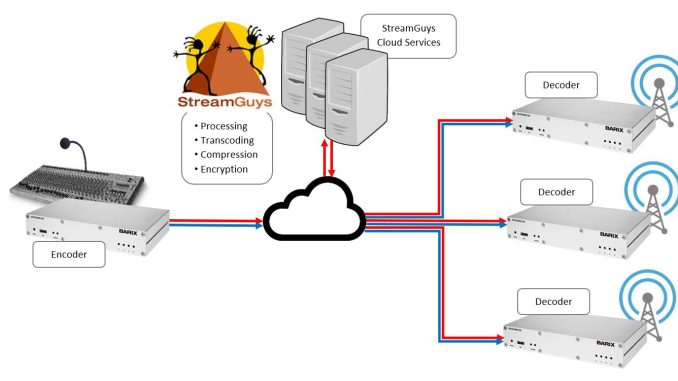
IP audio innovator Barix comes to NAB Show 2023 with Reflector EVO, its next-generation cloud service for audio contribution and distribution. Reflector EVO improves on the original Reflector service, introduced in 2010, by adding guaranteed absolute audio delay, improved stream redundancy, browser-based confidence monitoring and OPUS audio support. Barix will also introduce a new broadcast-specific hardware codec at NAB to pair with the Reflector EVO service.
Same as the original service, StreamGuys will provide virtual cloud hosting and 24/7 back-end support, providing broadcasters with an accessible service for unidirectional STL connections, syndicated program distribution, and stream replication for rebroadcasts, retransmissions, and other audio services. The result is a reliable, scalable, and affordable alternative to satellite contribution and distribution with best-of-class service hosting and technical support.
Reflector was a true groundbreaker upon introduction 13 years ago. Reflector made it simple for broadcasters to connect an encoder and decoder over the public internet to move high-quality audio. It removed the network configuration challenges of fixed IP address and firewalls, and brought tedious negotiations with network administrators and ISPs to a halt.
“IP networking was largely an unknown entity for broadcasters through the 2000s, and it was a complex undertaking for the early adopters,” reflects Reto Brader, CEO of Barix. “Reflector took the complexity out of the equation. A few clicks in the Reflector UI, a few settings on the hardware devices, and the audio started to flow. More than a decade later, the fundamental value of the original Reflector service remains; Reflector EVO tackles the modern IP networking challenges of larger networks while adding meaningful features for broadcasters.”
OPUS audio is among those new features, giving broadcasters a high-quality, bandwidth-efficient option to uncompressed PCM streaming and other compressed audio codecs that Barix continues to support in Reflector EVO. Barix also takes longtime Reflector users into new territory by enabling fixed end-to-end audio delay for the first time. Customers can manually configure encoding quality and the desired audio delay level of the receiving decoder (between three and 30 seconds), with seamless communication between each device from any global location. Primary and backup streams optimize resiliency, recovering lost packets from network glitches through redundant paths and multi-source switchover capabilities.
“Cloud adoption is moving ahead in the broadcast community, and Reflector EVO supports the high level of redundancy and scalability that customers expect from cloud services,” said Brader. “We have introduced redundancy to correct for short bursts of data loss and heal those losses in the stream, and expanded enabled fast switching from one encoder to another. That means more geographically distributed source locations, such as backup studios, to optimize redundancy. Scalability has always been a strength of Reflector, which is why it is popular for program syndication and multipoint STL distribution. A few clicks, and a new location is live.”
The new corresponding hardware codec, developed specifically for Reflector EVO, can be configured as an encoder and decoder. The codecs feature the same embedded technologies under the hood and are quick to deploy once configured, with simple connections at the transmit (encoding) and receive (decoding) points. The codecs also provide flexible switching options (contact closures, UDP commands), relay support, and selectable input gain.
Brader is grateful to continue its partnership with StreamGuys for the next generation of Reflector. “Barix understands radio broadcast requirements such as controlled audio delay through the system, the need for remote contact closures that synchronize with program audio, and so on. StreamGuys is a trusted service provider for live and on-demand broadcast streaming that excels in service reliability and 24/7 availability. The two companies together provide a complete cloud solution for radio broadcasters worldwide.”
